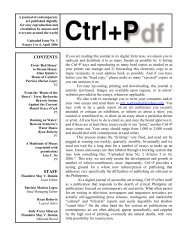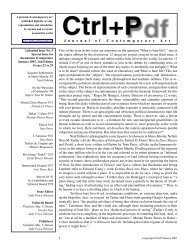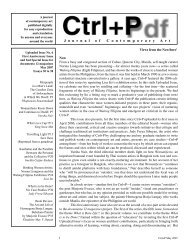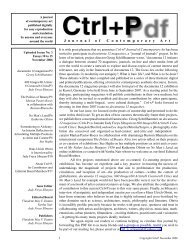Issue 15 - Pdf Ctrl+P - CTRL+P: a journal of contemporary art
Issue 15 - Pdf Ctrl+P - CTRL+P: a journal of contemporary art
Issue 15 - Pdf Ctrl+P - CTRL+P: a journal of contemporary art
You also want an ePaper? Increase the reach of your titles
YUMPU automatically turns print PDFs into web optimized ePapers that Google loves.
who believe their pr<strong>of</strong>essional endeavors should transcend market concerns, appealing<br />
instead, to aesthetic, philosophic, or even ethical and moral concerns. No less than Eileen<br />
Legaspi-Ramirez, guest- and co-editor for this issue expressed such anxiety, by prefacing<br />
her editorial with a disclosure about her soiled image <strong>of</strong> the <strong>art</strong> market and a recounting<br />
<strong>of</strong> her painful encounter, in 1994, with “vultures” who were circling her grandfather’s,<br />
National Artist Cesar Legaspi’s, deathbed knowing that their investment will multiply<br />
at his passing.<br />
Marina Cruz, a young rising star whose success in <strong>art</strong> fairs and auctions Legaspi-<br />
Ramirez describes as “dramatic” expressed at one point during her talk in the forum:<br />
“Are we less ‘good’ because we are commercially successful?” All she desires (perhaps<br />
naively, as another panelist points), she says, is for her work to be appreciated by the different<br />
publics—from the most knowledgeable <strong>of</strong> insiders to the least initiated <strong>art</strong> world<br />
‘outsiders,’ the people who, driven by curiosity, take the time to stop and look at the works<br />
she was documenting outside her house. The fact that collectors buy her works is a stroke<br />
<strong>of</strong> luck she is humbly grateful for, but like other <strong>art</strong>ists present in the forum, she values<br />
critical validation and recognition equally, if not more, than her commercial success.<br />
Joselina Cruz in her talk, on the other hand, took the <strong>Ctrl+P</strong> forum brief to task<br />
for what she perceived as unproblematized observation that boundaries are blurring between<br />
biennales/triennales, on one hand and <strong>art</strong> fairs, on the other. The first Philippine<br />
curator to join an international curatorial team in the biennale mode, Cruz insisted that<br />
while both have validation powers, the latter are more open-ended, more price-driven.<br />
Biennales, on the other hand, are more rigorously framed by a theoretical and critical<br />
mentality, even if such criticality is <strong>of</strong>ten compromised and limited—as she relates in<br />
her essay on her experiences curating the most recent Singapore Biennale—by logistic<br />
and contextual givens. Caught between what Gina Fairley describes as “a schizophrenic<br />
ricochet between the institutional white cube and the raw (un)familiar site, which has<br />
increasingly become a marketing chip to identifying and growing these events to local<br />
and international audiences” and layered “with a trend to package these exhibitions with<br />
other events,” the biennale’s critical and self-reflexive edge, st<strong>art</strong> to blur—exactly the<br />
point <strong>of</strong> the <strong>Ctrl+P</strong> forum brief and call for papers.<br />
For Eliza Tan, the Venice Biennale similarly <strong>of</strong>fers nothing perspectivally fresh,<br />
although she took diligent note <strong>of</strong> the good pace, narrative roundness and accessibility,<br />
and the hushed, un-ostentatious character <strong>of</strong> works in the curated segments. And in a<br />
more optimistic vein, Patrick Flores hailed the Gwanju Biennale as having a more robust<br />
theoretical frame and discussion, which was absent, he writes, in other eight biennales<br />
that opened in the same season <strong>of</strong> the year in Asia. Contributing to a section <strong>of</strong> Gwanju<br />
Biennale called Position Papers, he centered on four germinal figures on Southeast Asia,<br />
one <strong>of</strong> whom, Raymundo Albano, pioneered the Cultural Center <strong>of</strong> the Philippines (CCP)<br />
collection. The contributions <strong>of</strong> Albano along with other lively minds <strong>of</strong> the early 70s to<br />
the 80s, most <strong>of</strong> whom are still active today (Sibayan, Pastor Roces, Chabet, to name a<br />
few) are reckoned with in Flores’ other essay in this issue—a reprint from the catalogue<br />
on the survey exhibition on the CCP collection, “Suddenly Turning Visible.”<br />
Jay Bautista’s essay on Philippine competitions rounds out—though in a less scholarly<br />
and critical vein—the material on the Philippine <strong>art</strong> world. It contains historical<br />
information that may prove useful to the uninitiated as well as anyone who is unfamiliar<br />
with Philippine <strong>art</strong> history. Along with the brief review <strong>of</strong> the Thirteen Artists Awards by<br />
Rina Alphonso, which the CCP bestows on young <strong>art</strong>ists nominated and deemed promising<br />
by a panel <strong>of</strong> jurors, Bautista’s essay tells us that, critical as we may be <strong>of</strong> competitions<br />
and awards, they remain influential shapers <strong>of</strong> careers, <strong>art</strong>istic directions and values,<br />
even as they are beset, as Legaspi-Ramirez recounts in her experience as juror, with the<br />
infrastructural and logistic constraints that similarly limit resource-rich blue-chip events<br />
like the biennales and triennales.<br />
As I write this, the CCP is holding a necrological service for the National Artist<br />
Awards, believed to have “died” because tainted by the unprincipled intervention <strong>of</strong> the<br />
state led by an unethical leader and her cohorts. Questions <strong>of</strong> creative autonomy, respect<br />
for peer-initiated process, and delicadeza vis-à-vis presidential prerogative empowered<br />
<strong>Ctrl+P</strong> September 2009







